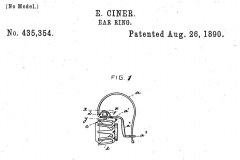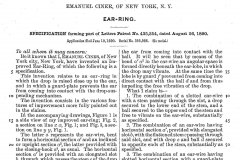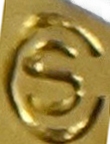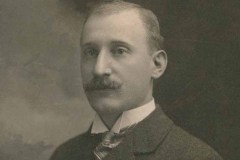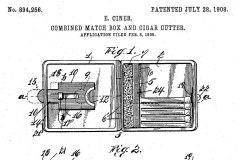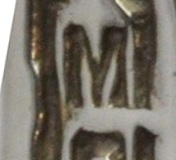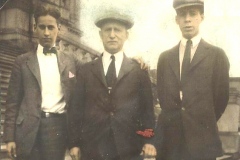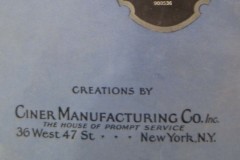The Early Years of Ciner Jewelry: Manufacturers of Fine Jewelry
1892-1929
1866-1872: Emanuel Ciner came as an infant to America and lived on the Lower East Side of New York City. His father died suddenly when he was 11 years old.
1872-1892: Emanuel was forced to leave school and apprenticed as a watchmaker and jeweler.[1] He then worked for several jewelry companies.
1890: Emanuel patented an “Improved Ear-Ring” (Patent dated August 26; No. 435,354).
1892: Emanuel Ciner, at age 28, started his own business.
- Business listed as “Diamonds,” 44 and then 60 Maiden Lane on the Lower East Side of New York City.[2] From 1795, Maiden Lane was the center of the jewelry district.
- Emanuel took in a salesman.[3] His other employee was Samuel Raives. Raives was a Jewish immigrant from Russia who had married Emanuel’s sister in 1889.
1897: Business as “Jeweler.”[4] The New York State Factory Inspection Report: diamond mounting factory with 4 male employees who also worked 7½ hours on Saturday or Sunday. One of the employees was a male under 16 who worked 50 hours a week.[5]
1898: Ciner & Seeleman. Emanuel Ciner took on a partner, Louis Seeleman. Seeleman was born in Illinois in 1874. His father was born in Germany and his mother in France.[6]
1898: Ciner & Seeleman had 8 male employees who worked 51 hours a week.[7]
- Seeleman and Raives were salesmen, selling to wholesalers and retailers. They traveled to various big cities. The Jewelers’ Circular in 1899 listed in the section on traveling salesmen that S. Raives, a salesman for Ciner & Seeleman, was in St. Louis, Missouri on business.[8]
- Emanuel was in charge of the factory. He concentrated on manufacturing ‘Tiffany Rings.’ These were simple settings that everyone bought for their engagement rings. The pieces were sold by the weight, and it was highly competitive.
1900: Ciner & Seeleman moved to 35 Maiden Lane. There was a fire in the floors above them, but its factory sustained only slight damage.[9] The business was listed as “Rings.”[10] They took on another partner: Julius Bernstein was Seeleman’s brother in law. Bernstein was born in 1852 and emigrated from Russia in 1866. He was a diamond importer.[11] That partnership was dissoved in 1901.[12]
1901: Ciner & Seeleman moved to 87 Maiden Lane.
1903: In City Directory list of jewelry manufacturers.[13] Listed in Directory of Copartnerships and Corporations.[14]
Ciner & Seeleman specialized in rings. The company also produced gold necklaces with diamonds and pearls in the Edwardian and Art Nouveau styles.
1907: Ciner & Seeleman was a member of the Hebrew Infant Asylum of the City of New York, giving the lowest level of donation. The company donated $2 to Help to Self-Help (The People’s University Extension Society of New York)[15]
1908: Emanuel took out a patent for a Combined Match-Box and Cigar-Cutter in 1908.
1910: C & S Novelty Co., 87 Maiden Lane, Emanuel Ciner, President; Louis Seeleman, Secretary. Directors: Emanuel, Louis Seeleman, and Samuel Raives. Capital was $50,000.[16]
1910: Ciner & Seeleman Incorporated to manufacture jewelry. Incorporators: I.W. Neuwirth, L Seeleman, and E. Ciner.[17] Isidore W. Neuwirth, born in New York City of Hungarian emigrants, was a commission salesman for the company.[18]
1910: Bankruptcy proceedings. The Financial Panic that began in 1907 brought on financial troubles. Published in The New York Tribune: Emanuel Ciner and Louis Seeleman, “who compose the firm of Ciner & Seeleman, manufacturing jewelers, at No. 87 Maiden Lane….” The attorneys for the creditors, a list of creditors and amounts owed were detailed. A reciever appointed by judge. The company’s “liabilities are about $200,000 and assets more than $50,000.”[19]
1910: Bankruptcy proceedings agains Samuel Raives, the husband of Emanuel’s sister, who was president of a corporation which dealt in selling jewelry on installment. Among its creditors was Ciner & Seeleman, which was owed $8,540.[20]
1912: Ciner & Seeleman employed 14 Men and 3 women in its shop; 4 people worked in its office.[21]
1913: Ciner & Seeleman employed 20 Men and 3 women in its shop and 7 in its office.[22] (Source:.)
1913: Ciner & Seeleman made an in kind donation to the Hebrew Infant Asylum of the City of New York.[23]
1913: Ciner & Seeleman dissolved.[24]
1914: Ciner Manufacturing Company, Inc. established.
1915: New factory at 51 Maiden Lane. Listed under Jewelers—Manufacturers. Emanuel, President and treasurer; Isidore W. Neuwirth, Vice President; Sam Raives, Secretary.[25]
1917: Donated $25 to Jewish War Relief Fund organized by Jewelers’ Committee. In comparison, Tiffany & Company donated $2,500 and Joseph Mazer, $50.[26]
1917: Purchased $1,000 of New York Liberty Bonds. New York Liberty Bond Purchasers. List compiled by National Jewelers’ Board of Trade. In comparison, Tiffany & Company bought $756,350, Black Starr & Frost, $4,550.[27]
1920: Emanuel’s eldest son Irwin joined the company when he was 18.
- Irwin Ciner recalled: His father said he would not ask Irwin to join the business, but if he wanted to join he would love to have him. He told him it would be rough. Irwin started out working by sweeping the floor. Then if Irwin wanted to work at the bench Emanuel let him. At that time Irwin was allowed to make men’s stick pins.
1920s: 50 workers in the factory; most of them were Russian Jewish immigrants. Martin Kraus [sp.?] was the factory foreman. Kraus was an orphan who was related to Emanuel’s wife.
- Ciner Manufacturing Co. did special order work. They reset styles into white gold from yellow gold so it looked more modern. pioneered in the manufacturing of white gold jewelry. Prior to this platinum or yellow gold had been used. Platinum was used because it showed off the diamonds better because it could reflect the light.
1920: Moved to 45 Lispenard Street.
- 45 Lispenard Street, south of Canal street, was occupied by jewelry companies. They, and other jewelers, had to move from Maiden Lane because The Federal Reserve Bank of New York planned to build a new building, and insurance companies wanted move to the area.[28]
- The lease was signed by Henry Baschkopf for Ciner Manufacturing Company. Baschkopf was a Jewish jeweler who was born in Austria; he started his own jewelry business in 1922.
1922: Emanuel’s second son Charles (“Charlie”) joined Ciner Manufacturing Co.
1922: Ciner Manufacturing Company, Incorporated, Manufacturers of Jewelry, applied to join the Merchants’ Association, NYC. Mr. E. Ciner, President and Treasurer. [30]
1925: Emanuel, President and Treasurer; Irwin, Secretary; and Isidor W. Neuwirth Vice President.[31]
1926: Ciner Manufacturing Company moved to mid-town Manhattan, 36 West 47th Street.[32]
- The building’s owners of the building wanted to fill it with jewelry manufacturers, diamond merchants, and gold importers. It was the first building for jewelers on West 47th Street that would become the industry’s most famous marketplace.
Selling Ciner Jewelry
1918: A newspaper story told of an incident of one of Ciner’s long-time traveling salesman: Isidore Neuwirth stayed at the Iroquois Hotel in Buffalo. He was robbed by a hotel porter of 651 pieces of jewelry valued at $9,000. The jewelry was later recovered in Chicago and returned to Buffalo.[33]
- Since customers did not come to the factory, Charles and Irwin joined the other salesmen. Traveling by railroad, Irwin visited customers in the South—to cities like New Orleans. Charles was the salesman for the Midwest and East Coast. Each salesman carried samples in a big trunk. When he arrived at a hotel, he had to get a room where he could lay out the jewelry. Buyers came to the hotel room.
- Late 1920s: With his small, but uniquely skilled staff, Emanuel created stylish gold and platinum pieces that were as highly regarded as the work of many of the finest jewelers of his day. With his two sons in the business, the future manufacturing and selling precious jewelry looked bright.
Notes
- Sources: Interviews with Irwin Ciner and Charles Ciner. Ciner Manufacturing Company, “Ciner Historical Backgrounder,” 1992. Other sources as noted. ↑
- Trow’s New York City Directory, 1893, p. 236. Trow’s New York City Directory, 1894, p. 233. New York City Directory, 1895, 240. ↑
- The Jewelers’ Circular, July 28, 1897, 23. ↑
- New York City Directory, 1897, 244. ↑
- Factory Inspector, Documents of the Assembly of the State of New York, 1897, 186. ↑
- US Census 1900; 1910. ↑
- Factory Inspector, Documents of the Assembly of the State of New York, 1898, 235. ↑
- The Jewelers’ Circular, June 21, 1899, 28. ↑
- “Yesterday’s Fires,” New York Times, March 22, 1899, 2. The Jewelers’ Circular, May 17, 1899, 27. ↑
- New York City Directory, 1900, 217. ↑
- US Census, 1900. ↑
- New York Times, April 15, 1901, 8. ↑
- New York City Directory, 1903, 713. ↑
- New York City Directory, 1901, 226. ↑
- Hebrew Infant Asylum of the City of New York Thirthteenth Annual Report, 1908, 48. Annual Report Help to Self-Help (The People’s University Extension Society of New York), 1907, 152. ↑
- The Trow, Copartnership and Corporation Directory of the Boroughs of Manhattan and the Bronx, 1909, 118. New York City Directory, 1910, 251. ↑
- American Machinist, January 12, 1911, 89. ↑
- Isidore Neuwerth [Neuwirth], 1910 US Census. ↑
- New York Tribune, September 25, 1910. ↑
- New York Times, October 19, 1910. ↑
- New York State Department of Labor, First Annual Industrial Directory of New York State. 1912, 197. ↑
- Report as of Sept. 30, 1913. New York State Department of Labor, First Annual Industrial Directory of New York State. 1913, 405. ↑
- Annual Report of the Hebrew Infant Asylum, New York City, 1914, 41. ↑
- Manhattan Telephone Directory, October 1913, February 1914. Directory of Directors in the City of New York 1913-1914, 114, 578, 468. ↑
- Manhattan Telephone Directory, February 1914. New York City Directory, 1915, 468. New York City Directory, 1916, 399. New York City Directory, 1916, 2232. New York City Directory, 1916, 918. New York City Directory, 1917, 514. I. Neuwirth, VP, Trow’s New York City Directory, 1917. White, Orr & Company, The Reference Register, 1918-1919, Compendium for General Business Reference. ↑
- Jewelers’ Circular-Weekly, December 12, 1917, 73. ↑
- Jewelers Circular, November 17, 1917, 63-4. ↑
- New York Tribune, January 8, 1920; Trow’s New York City Directory, 1925. ↑
- New York Tribune, January 8, 1920. New York Times, January 8, 1920. New York Times, June 21, 1922. ↑
- “Applicants for Admission Knocking at the Door,” Greater New York, November 20, 1922, 47. ↑
- Trow’s New York City Directory, 1925. ↑
- Manhattan Telephone Directory, Summer 1926. ↑
- Chicago Tribune, May 24, 1918, 1. ↑
